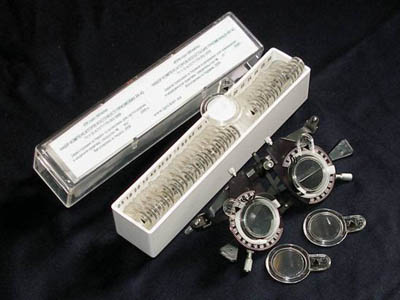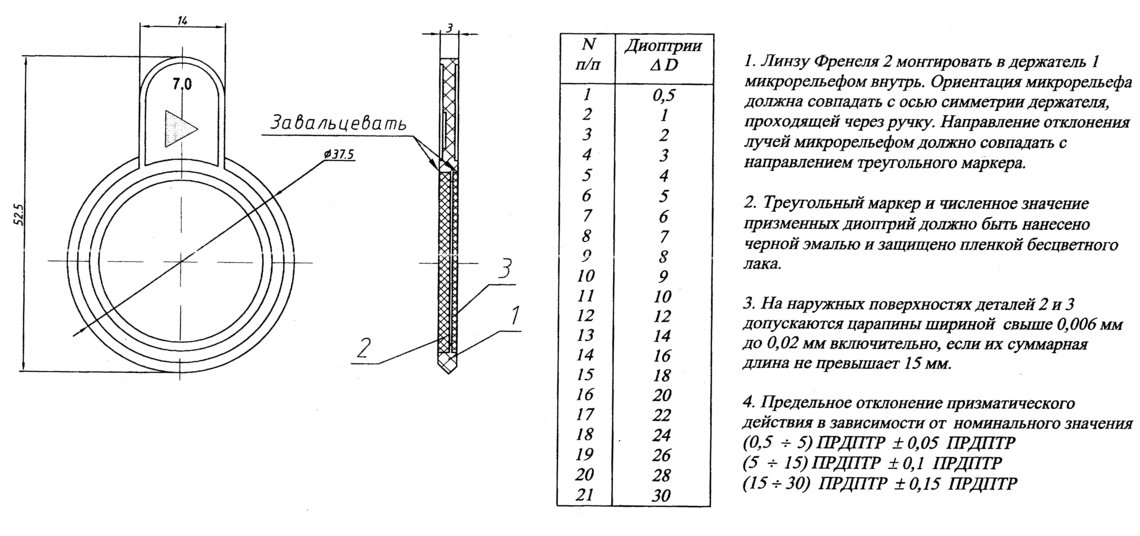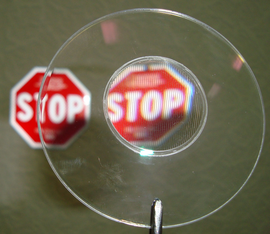Fig. 1. Diagnostic set of strabismus prism compensators KK-42
Diagnostic set of strabismus prism compensators KK-42
The Institute, together with the Kyiv Eye Microsurgery Center, developed technical requirements for a diagnostic set of strabismus microprism compensators and technical requirements for the design of a separate compensator, on the basis of which the diagnostic set of strabismus microprism compensators KK-42 was developed [1, 2].
The set consists of 42 prisms (21 prisms for each eye), with the prismatic strength: 0.5; 1; 2; 3; 4; 5; 6; 7; 8; 9; 10; 12; 14; 16; 18; 20; 22; 24; 26; 28; 30 prismatic diopters (PD), i.e. in the range from 1 to 10 PD, the discrete step is 1 RD, in the range from 10 to 30 РD - 2 РD (Fig. 1).
A single compensator consists of a generator frame (1), a microprism element (2) and a protective plate (3) (Fig. 2).
Forming the round shape eye-glass rim with a handle - holder (1) during the diagnosis set in the test the rim of an eye-glass. The thickness of the the eye-glass rim is 3 mm, the outer diameter is 37.5 mm, which corresponds to the diameter of the lens holder of the test eye-glass rim. The eye-glass rim has two annular recesses for fastening its with a microprism element and a protective plate.


Microprism element (2) is a plate of a round shape, one side of which is flat, and the other one has microprism relief of a corresponding profile, which provides beam deflection and creates the necessary optical power of the compensator. Microprism element is hermetically connected to the eye-glass rim in one of its recesses with relief inward. In the second recess, the protective plate (3) is hermetically fixed, as a result of which the microrelief is located inside the compensator, does not come into contact with the external environment, and is not exposed to external contamination. The tightness of the design of the compensator allows in the process of operation to carry out multiple sanitary processing, disinfection and cleaning with standard means without damaging and contaminating the microrelief structure.
On the handle-holder marked the direction and strength of the prismatic strength of the compensator. The figure marked on the pen indicates the magnitude of the prismatic strength in PD, and the triangular marker is the orientation of the prisms of the microrelief - the base of the triangle corresponds to the location of the base of the prisms.
The accuracy of manufacturing Fresnel prisms is very high and is characterized by a maximum deviation of the obtained prismatic strength from the nominal, and which, depending on the dioptric value, is + 0.05 PD for prisms from 0.5 to 5.0 PD + 0.1 PD for prisms from 5 0 to 15.0 PD and +0.15 PD for prisms from 15.0 to 30.0 PD.
The prismatic strength of each compensator is monitored on a stand certified by Ukrstandart, the accuracy of which is 0.005 PD and ensures the accuracy of measurements.

Fig.2. A single strabismus prism compensator.
The manufacturing technology of compensators also ensures their high optical quality. The coefficient of light transmission of each compensator is not lower than 80%.
The exact value of the prismatic strength of compensators is realized with a normal incidence of the beam on the microprism from the side opposite to the relief.
According to this scheme, both the changes in the magnitude of the prismatic force of the compensators on the measuring stand and the measurement of the strabismus angle are performed, during which the use of microprism elements in the test frame instead of thick and heavy glass prisms makes it easy to ensure a strictly normal microprism position relative to the visual axis most increase the accuracy of diagnosis.
The diagnostic set of strabismus prism compensator KK-42 passed all types of tests (toxic-hygienic, sanitary-chemical, sanitary-epidemiological, preclinical and clinical) and the certificate of State Registration of the product was received. The set is entered in the state register of medical equipment and medical products and is allowed for use in medical practice.
The main purpose of the diagnostic set is the diagnosis of various types (convergent, divergent, vertical, combined) strabismus, strabismus angle measurements, selection of corrective prismatic glasses using the cover test method with prisms.
In addition, individual compensators from a set with a prismatic power of 2,4,6,8,10 РD can be effectively used in diploptic eye training.
Diagnostic sets of optical strabismus compensator
For ease of use of strabismus compensators, sets of diagnostic lines for strabismus compensators of DNSC-1 were developed and manufactured. The peculiarity is that optical compensators are formed by two identical planar microprismatic elements arranged reliefs towards each other, as a result of such the value of the prismatic strength of the compensator practically does not change when the bar turns along its axis.
The calculated and experimental data show that the change in the magnitude of the prismatic strength when turning the prisms is almost four times less for the case once the corresponding magnitude of the prismatic strength of the optical compensator is created by two identical microprismatic elements.
Fig. 3 shows calculated (dashed line, curve 1) and experimental (solid line, curve 2) data on the change in the magnitude of the prismatic effect of PD if rotating symmetric dual microprisms along the direction of the relief, and calculated (dotted line, curve 3) and experimental (line, curve 4 ) data on the change in the value of PD when rotating single microprism elements.
The size of the chromatism zone for microprisms, that affects the clarity of the visual image and the corresponding visual acuity, is the same for single and dual symmetric elements and is determined only by the value of the prismatic strength of element D. Thus, there is no deterioration in visual acuity associated with chromatic phenomena, the use of dual microprisms in comparison with the case of single microprism elements.

Fig. 3. Comparative characteristics of symmetric dual set
(curves 1-2) and single (curves 3-4) microprisms
prismatic strength PD = 28,0 D:
(curves 1.3 - calculations, curves 2.4 - experiment)
The results obtained unambiguously indicate that symmetric strabismus compensators can indeed provide more accurate results of strabismus angle measurements using prism skiascopy with the use of micro-prim diagnostic bars. Therefore, in recent years, diagnostic set formed exclusively with the application of symmetrical compensators.

Fig. 4. A set of diagnostic bars
strabismus prism compensators DNSK-1
Bars for measuring horizontal angles have compensators of such nominal prismatic strength:
(I) 1, 2, 4, 6, 8, 10 prismatic diopters;
(II) -12, 14, 16, 18, 20, 25 diopters;
(III) -30, 35, 40, 45, 50, 55 diopters.
Bars for measuring vertical angles include such compensators:
(IY) - (up) and (Y) - (down) 5, 10, 15, 20, 25, 30 diopters;
Sphere-prismatic lenses
It is known that children's strabismus is usually accompanied by other visual defects. Therefore, the further development of these works was the development of manufacturing technology for sphero-prismatic lenses, combining the characteristics of prismatic and spherical, including astigmatic, lenses (Fig. 5).


Fig. 5. Microprismatic Fresnel lens of the combined action:
1– spherical lens; 2 - plate with microprismatic relief.
Конструктивно такие линзы представляют собой стандартную сферическую линзу (1) из поликарбоната, к внутренней поверхности которой методом ультразвуковой сварки приваривается герметично рельефом внутрь микропризма Френеля (2) необходимого призматического действия.
Сферо-призматические линзы изготавливаются индивидуально, по рецепту врача, в любой комбинации оптического действия составляющих элементов:
– сферическая линза с оптической силой от 0 до ± 8 РD
– призма Френеля с призматическим действием от 0 до 30 РD
Institute for Information Recording of the National Academy of Sciences of Ukraine
Ukraine, Kyiv, 03113, st. N.Shpaka, 2
Tel. + (380 44) 456 83 89
Fax + (380 44) 456 33 18
e-mail: IIR@IIR.Kyiv.ua
Group of work with patients and doctors
Ukraine, Kyiv, 03113, st. N.Shpaka, 2
Tel. + (380 44) 456 48 49
+ (380 44) 454 21 93
+ (380 44) 454 21 95
Mob + (38) 063 616 11 84
Fax + (380 44) 454 22 22
Web: http://fren.com.ua/
e-mail: IIR@IIR.Kyiv.ua
